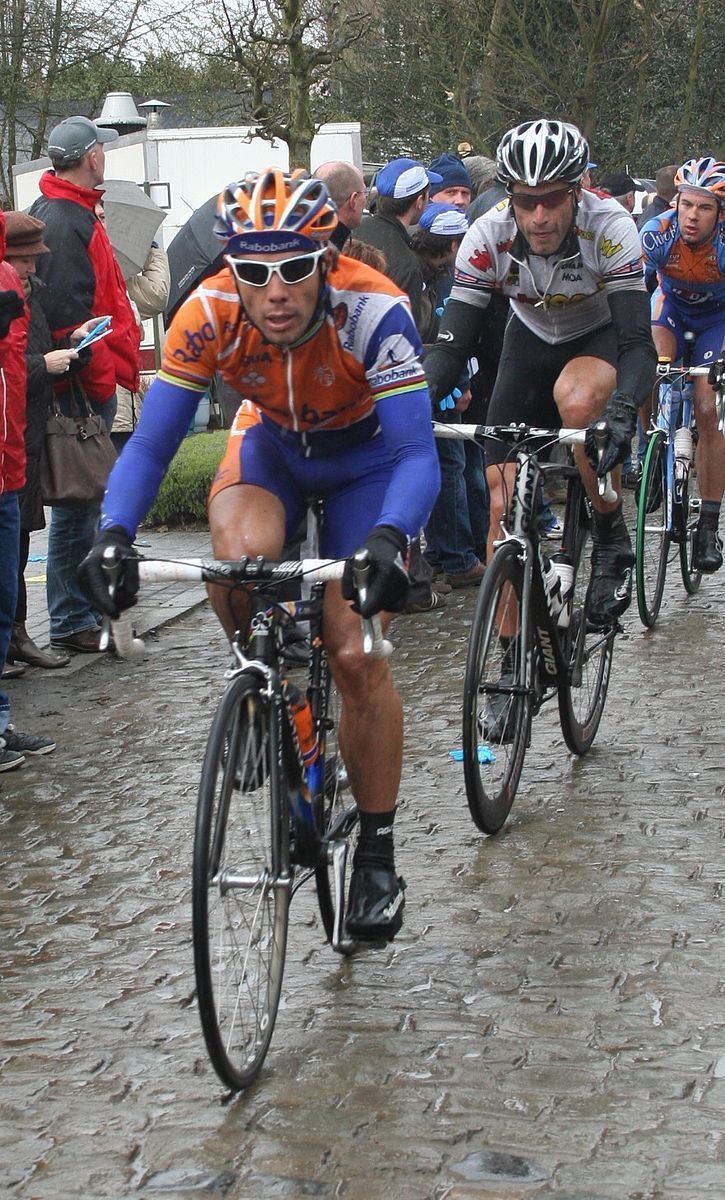 | ||
The Ruban Jaune (English; Yellow Ribbon) is a cycling trophy created in 1936 by Henri Desgrange, awarded to the rider recording the fastest average speed in a professional cycling race or stage longer than 200 km. The trophy’s name is thought is to have come from comparison with the Blue Riband trophy awarded to the passenger liner crossing the Atlantic Ocean in record time. Desgrange changed the colour to yellow to reflect the newsprint of L'Auto, the sports newspaper he edited. The timing of the record must be by two independent timekeepers using certified timing equipment which has been recently calibrated. Because of these strict rules it was unofficially accepted in the latter part of the 20th century that only times in classic races would be accepted.
History
The first holder of the Ruban Jaune was Gustave Danneels of Belgium, who won the 1936 Paris–Tours in 41.455 km/h. Paris–Tours was long associated with the Ruban Jaune because its flat course, coupled with a following wind, makes for a fast speed. Jules Rossi of Italy took the record in 1938 when covering 251 km at an average 42.092 in Paris–Tours.
The suspension of top-class cycling during World War II meant Rossi’s record stood for ten years until April 4, 1948, when Rik van Steenbergen won Paris–Roubaix at 43.612 km/h. The race had a violent tailwind. Van Steenbergen attacked at Hem 6 km from the finish, catching Emile Idée and Fiorenzo Magni and then beating Idée in a sprint in Roubaix Velodrome. In 1955 the record returned to Paris–Tours when Jacques Dupont covered the 253.7 km at 43.766 km/h.
Dupont held the record until 1962 when Jo de Roo won Paris–Tours at 44.903 km/h over 267.5 km. However, the previous year had two unratified claims. Jean Anastasi won a 218 km stage of the 1961 Paris–Nice between St Etienne and Avignon at 44.917 km/h. The record was not recognised because the course had not been properly measured. Also in 1961 Walter Martin of Italy won Milano–Torino in 45.094 km but this too was not accepted.
In 1964 Peter Post claimed the Ruban Jaune in winning Paris–Roubaix in 45.129 km/h,the race run at speed from the start. This was augmented by the final break at Attiches 33 km from the finish. It contained two riders from the Flandria team and three from Weils-Groene-Leeuw and they worked together to keep a high speed with the race decided in a sprint. Post’s record stood for more than a decade although the 1969 Milano–Vignola was initially won by Roger Kindt in a record average of 45.995 km/h before he was disqualified at the medical control and victory was awarded to Attilio Rota. Post’s record was beaten by Freddy Maertens in the 1975 Paris-Brussels, an average 46.11 km/h over 285.5 km.
Andrei Tchmil set a record in 1997 when he won the 254.5 km Paris–Tours in 47.168 km/h. The race covered 49.3 km in the first hour and 48.9 km in the second. Tchmil beat Max Sciandri in a sprint after the two had broken away 5 km from the finish. Erik Zabel set a new best in the 2003 Paris–Tours of 47.55 km/h over 257 km, a brisk tailwind pushing the race over 51 km in the fourth hour as the riders flew down the Loire valley. Zabel eventually won the race in a bunch sprint in Tours. On October 10, 2010 Óscar Freire broke the record yet again in Paris–Tours, taking advantage of a favourable wind over a new shortened course of 233 km, he covered the distance in 4 hours 52 mins 54 seconds at an average speed of 47.730 km per hour.
